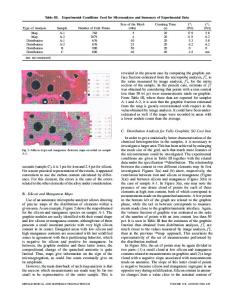Nucleation and Growth of Graphite in Eutectic Spheroidal Cast Iron: Modeling and Testing
- PDF / 2,156,693 Bytes
- 17 Pages / 593.972 x 792 pts Page_size
- 10 Downloads / 418 Views
INTRODUCTION
NODULAR cast irons are alloys in which the main components are Fe, C, and Si. From a technological perspective, the quality and mechanical properties of nodular cast irons depend on the type and characteristics of (1) graphite spheroids and (2) metallic constituents. According to ASTM A247-10,[1] three of the main characteristics of graphite in iron castings are (1) the graphite form type (or types), (2) the graphite distribution, and (3) the graphite size class. To the best of the authors’ knowledge, previous contributions have not addressed the coupling of phase transformations in liquid and solid states to monitor the evolution of these FERNANDO D. CARAZO, Professor and Researcher, is with the Instituto de Meca´nica Aplicada, Universidad Nacional de San Juan, Av. Libertador Gral. San Martı´ n 1109 (Oeste), C.P. J5400ARL, San Juan, Argentina, and also with CONICET, C1425FQB Godoy Cruz 2290, CABA Argentina. Contact e-mail: [email protected] PATRICIA M. DARDATI, Professor, is with GIDMA and Departamento de Ingenierı´ a Meca´nica, Universidad Tecnolo´gica Nacional Facultad Regional Co´rdoba, Maestro M. Lo´pez esq. Cruz Roja Argentina s/n, Ciudad Universitaria, Co´rdoba, Argentina. DIEGO J. CELENTANO, Professor, is with the Departamento de Ingenierı´ a Meca´nica y Metalu´rgica, Research Center for Nanotechnology and Advanced Materials (CIEN-UC), Pontificia Universidad Cato´lica de Chile, Av. Vicun˜a Mackenna 4860, Macul, Santiago, Chile. LUIS A. GODOY, Professor and Researcher, is with the Institute for Advanced Studies in Engineering and Technology, FCEFyN, National University of Cordoba and CONICET, Av. Ve´lez Sarsfield 1601, Co´rdoba, Argentina, and also with CONICET. Manuscript submitted June 9, 2015. Article published online March 22, 2016 METALLURGICAL AND MATERIALS TRANSACTIONS A
three characteristics during and at the end of the cooling process. Studies dealing with the thermo-metallurgical evolution of the complete cooling process of spheroidal eutectic cast iron[2–6] have limited microstructural capabilities to model phase changes. During solidification, they consider a non-divorced eutectic and do not take into account mass conservation of carbon at a microstructural level. At the solid state, they do not account for microstructural characteristics at the end of solidification, such as chemical heterogeneities at the microstructural level. Moreover, in order to identify the growth stages and laws of this phase, they represent neither the growth of graphite spheroids up to the initiation of the stable eutectoid transformation, nor the bounds of the intercriticals stable and metastable eutectoid. The computation of growth rate of graphite spheroids is limited to carbon diffusion through the shell of solid solution of carbon in Fea (BCC iron), namely ferrite, towards the spheroids. Venugopalan studied the growth of graphite spheroids during the continuous cooling of spheroidal cast iron.[7] The same author modeled the growth of graphite spheroids in an isothermal process.[8] In both works, there is
Data Loading...











